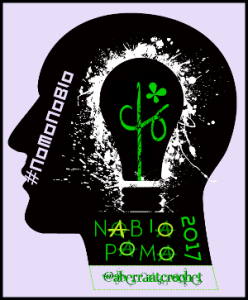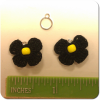It’s frustrating when you’re trying to reproduce a cute crochet pattern you found and yet it just doesn’t look anything like the photo you saw.
The problem could be something as simple, but profoundly affective, as this: Basic American crochet terms are different from European (including British and Australian) crochet terms.
And just because you grew up in the US doesn’t mean you necessarily learned crochet vernacular according to “American Crochet Standards.” Many patterns published in America during the 1800’s and early 1900’s also used terms from standards we refer to today as European or British.
So we’ll clear that up a bit today. And if you like to collect antique crochet patterns (as I do), take note because there are terms you’ll need to watch for, no matter which side of the ocean it came from.
What influenced the differences? I’m not really sure. However, the basic stitch we call single crochet in America, for instance, is called double crochet in Europe. As you can see, discrepancies in stitch terminology such as this can make a huge difference in end results.
Reference point: Australia, the UK and Europe in general all fall under the umbrella of “European terms.” Canada and the U.S. fall under the umbrella of “American terms.” Some refer to them instead as “American/British terms” or “UK/US terms.” For the purpose of this article, and the sake of clarity, I’ve simply left it at “European vs. American.” This list comes from my notes and cross-references over the years.
Here’s a quick list of American/European terms and their counterparts:
American: chain stitch (ch)
European: chain (ch)
These terms are essentially the same everywhere.
American: slip stitch (ss)
European: slip stitch (ss); sometimes shows up as single crochet in antique patterns (sc)
I have also seen slip stitch referred to as single crochet (sc) or “single stitch” in some British patterns, especially from the late 1800’s. Additionally, I’ve seen the terms “mitten stitch” and “close joining stitch” used.
American: single crochet (sc)
European: double crochet (dc)
I have also seen this referred to as “plain stitch” in some British patterns, especially from the late 1800’s.
American: half double crochet (hdc)
European: half treble crochet (htr) or extended double crochet
American: double crochet (dc)
European: treble crochet (tc)
American: triple crochet (tr)
European: double treble crochet (dtr or dbl tr)
I have also seen this referred to as a “long stitch” in some antique patterns.
American: double triple crochet (dtr or dtrc)
European: triple treble crochet (trtr)
I have also seen this referred to as an “extra long stitch” or “long treble” in some antique patterns.
American: triple treble (trtr or trtrc)
European: quadruple treble (quadtr)
American: yarn over (yo)
European: wool round hook (wrh) or yarn over hook (yoh)
American: skip
European: miss
American: gauge
European: tension
American: bind off or fasten off
European: cast off
OK! So these are the most common basic English terms you’ll run into out there while comparing crochet patterns from across the oceans.
Today it is pretty standard practice to print on the pattern whether the pattern is written according to American Crochet Standards or British/English/Australian/European Crochet Standards. I list all four there, because I have seen each of these in variation.
There are also Japanese, Chinese, Croatian, Scandinavian, South American and other terms as well, not to mention universal symbol crochet. But this will get you started with the most common terms published in English.
Thanks for reading! If you have resources and ideas to share, feel free to post them in the comments.
Until next time then….!
Go ahead and click a link below to “share this.” You know you want to! : )




 Crochet Liberation Front:
Crochet Liberation Front:












































Great reference post especially for people who enjoy using vintage patterns.
Thanks Kathryn!
Pingback: Spreading the Crochet Link Love | Crochet Concupiscence
I have a vintage patter that uses the term s.o.s. at the beginning of every round and I cannot find anything online that tells me what that means. Have you seen this before?
That’s a good question Ashley. 🙂 I haven’t personally seen it, but I have talked to people who have. And we don’t have a clear consensus on what it could mean. It could mean “stitch over stitch” indicating that a single crochet should be made over the previous row’s single crochet. Or it could mean “skip one stitch” for the beginning of a row. Does your pattern work in the round at all? In the end, it may require playing with it to see if you can figure it out. But I’ll ping some of my contemporaries and see if anyone else may have heard about it and see if we can get a definitive answer.
I will copy this response to you in email to make sure you get it, but do want to say thanks for your question and its meaningful addition to the conversation. 🙂
Update: Ashley wrote me to let me know she figured out the answer!
S.O.S. means “shell over shell.” At least in this particular #crochet pattern, which apparently features a pineapple design made from multiple shells. 🙂
Having a problem with a European pattern….Working all increases as set by last row, cont in htr fabric, inc
1 st at each end of 4th [4th: 4th: 5th: 5th] and 2 foll 4th [4th: 4th:
5th: 5th] rows. 74 [80: 90: 98: 108] sts.** HELP???
Hi Terre, thanks for your question.
Best I can tell from what you’ve posted, here’s how I would interpret the pattern:
“Working all increases as set by last row, continue in half-triple crochet fabric (fabric you’ve already created so far), increase one stitch at each end of 4th row [this section is for which ever size you are working on] and two stitches following (or after) the 4th [sizes again] rows. 74 [between the brackets is size variation info again] stitches total.”
It’s difficult to know for sure, since I’m not looking at the pattern, but that’s how I would read what you have here.
I highly recommend getting on Ravelry.com and posting your question on one of the crochet groups there as well. Two that come to mind are the Ravelry Crochet Group and The Crochet Liberation Front. These two groups are international and very active.
Blessings,
Jules
Pingback: Vintage Crochet Terms Translated | Roving Crafters
Pingback: My First Cardigan – color o'clock
I have been given a European crochet kit of a dragon.Down its back is a “picot” crest. The instructions read-ch 34 crochet back as follows: 1 dtr,2 sl st on the main chain. Every further crest : 2ch, 1dtr in the next mesh on the main mesh chain, 2sl st on the main mesh chain.
Can you please help with the translation into American?
Hi Doris,
Sounds like a neat project! A double-treble (or dtr) in European terms is the same as a triple crochet (tr) in American crochet terms. Slip stitch (ss or sl st) and chain stitches (ch) are the same across the ocean.
While not a classic style picot stitch, essentially the double chains in between the triple crochets create the picot crest ridge for the dragon’s back.
Let us know how it goes with your project and Happy New Year!
– Jules